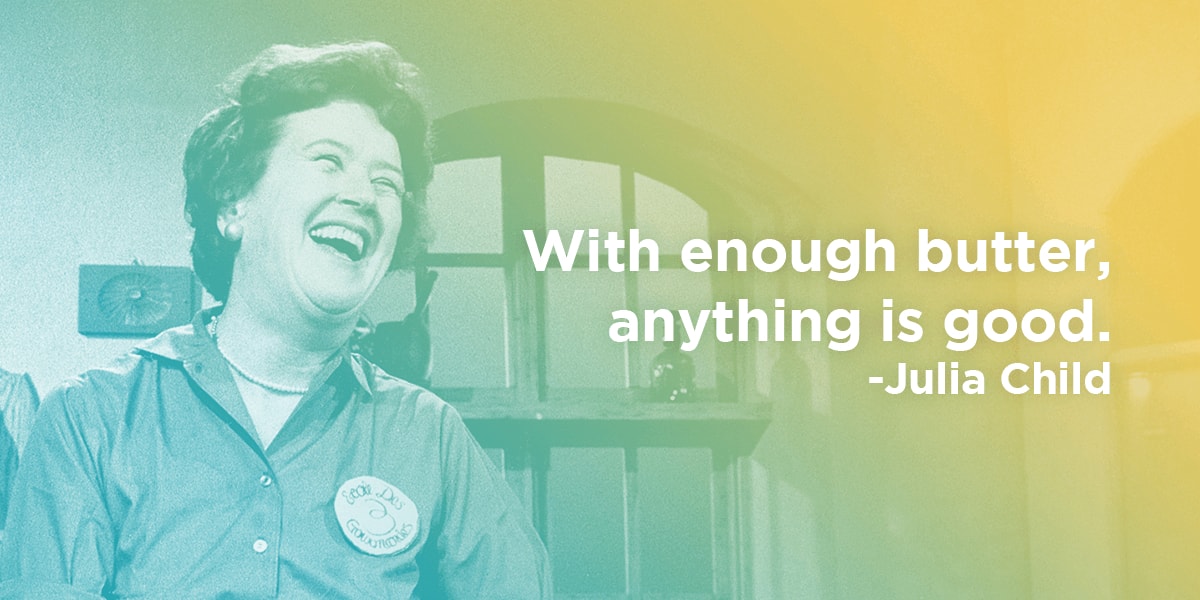
Like advertising, we tend to think of cooking as an art. We even call it that: culinary art. But in reality, it’s just as much of a science, and a chef is equally an artisan and a technician.
Advertisers need that same chef-like dichotomy. Along with artistic passion, we have to bring scientific precision to our work. That’s true in every aspect of advertising, but especially in how we weigh and measure the performance of campaigns.
That’s what this 4-part article is about. We’ll sift through some culinary attitudes and approaches to measurement. Combine, ruminate, digest them for delicious results.
Follow a recipe.

Advertising without a plan is like cooking without a recipe. You’re just feeling your way through it—a dash of this, a pinch of that, and a stick of butter.

Even if you luck into a tasty result thanks to the butter, you probably won’t recall exactly how you made it, let alone how to repeat or improve it. What’s more, even if the flavor’s good, is it the right kind of good?
- Should the pancakes you made have actually been cupcakes?
- Or muffins?
- And what exactly is the difference between a cupcake and a muffin?
It’s impossible to answer those sorts of profound questions unless you started with clear intentions to which you can compare end results. That’s why you need a recipe, or in this case, an advertising plan. Even if you’re trying out a mix of ads for the first time or adding a new placement or two, you’ve got to do it in a controlled manner. That means documenting each type of ad you’re going to run—search, display, social, email, etc.—along with your goals, audience, budget, and time frame for them.
What if we do that and the recipe fails? Should we stick with the plan because it’s the plan even if it’s producing sour results? Of course, not. Ad plans, like recipes, should be modified if they’re not turning out right. However, the key to successfully changing a plan is having one in the first place. If you’ve documented what you’re doing and why, then you know your ingredients, can check them, and change any that spoil your plan. Just take the same methodical approach to modifying the plan that you took in writing it originally.
We know, it sounds like a lot of work. Like it could wear you out. But ya know what’ll really wear you out? Eating a stack of pancakes then trying to work a normal day.

Yes, that’ll drain you, but so will trying to justify the ROI of an ad campaign that lacks clear direction and measurable goals. Especially when your boss comes calling. If, on the other hand, you put in the effort up front to write a clear plan, it’ll save you work (and maybe your job) later on.
So you’ve got to follow a recipe, but your recipe should also follow two guidelines.
1. The Bigger Meal

That’s your overall marketing strategy. Your ad plan is a main dish, but it’s just one of many courses of action to gain market share and sales. Others include:
- Your Reputation and Star Rating—that’s the brand identity you’ve developed and story you’re telling throughout your website, products, and services
- What You’re Cooking Up—new offerings or updates to better serve customers
- Your Tableside Manners—all the ways you interact with people, whether on social media, your blog, or customer service calls
Put simply, you’ve got to make the meal go together. If you’re famous for French cuisine, but your cooks are making falafels, and your ads are promoting fajitas, then you’ve got a messy potluck of a marketing strategy. Don’t have a messy potluck of a marketing strategy.
2. The Tastes of Your Audience

Our marketing strategy should be made to order for customers, but we’re not always certain which flavors they prefer. That’s when market research is vital, and there are two ways to get it.
- Go shopping. You can buy ready-made market research—complete with a large sample audience, demographic data, competitors, and trends. This can give you a good taste of the overall market and your place in it. However, you will pay a premium for it, and it may lack certain insights specific to your business.
- Home-grow it. If you want truly fresh, organic insights, nothing beets (get it?) digging them up yourself through 1:1 interviews, focus groups, and surveys. What’s tough is surveying a wide enough field and harvesting a statistically relevant sample size.
The number of customers and prospects you’ll need will depend on your overall market, but there are free tools like this one from Survey Monkey that can help you determine how many people to include. This’ll ensure that you get substantial insights that’ll nourish your business.
That concludes our first part. In the next one, we’ll dig into some actual measurements and tools. Until then, like every good French chef says, “Bonne mesure!”
Not really. They don’t say that. Forget we said it, too.


